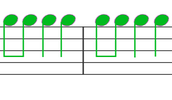Rhythm1
Notes Have Duration
Rhythm is the different durations of tones (sound). Though tones change pitch, each has a duration. These time durations are symbolized by the shape of a note.
To begin counting rhythm, we should know the different note shapes. Two note types are a quarter note and an eighth note. The quarter note is a full beat in a measure. The eighth note is a half of a beat, or a half beat.
Here are four measures of mixed quarter notes and eighth notes. Each measure has four beats, counted 1 2 3 4. Since eighth notes cannot make a whole beat, the rest of the duration of a beat is counted & (and).

These eighth notes are tied together by a beam (connecting them, in place of each flag). The quarter note still sounds until the next downbeat. Mentally, though, you can think of its total beat as '1&', or '2&', etc. Keep a constant pace by mentally counting '1&2&3&4&'. This helps predict where, in time, the beat falls.
Add a total half beat (eighth note) to another total half beat, and it equals a whole beat (quarter note). Don't stop counting the whole beat until the beginning of the next beat, because we need both of the half beats when we say '1&'.
Tap your foot; the downbeat falls when your foot touches the ground, and the upbeat is when your foot is all the way up. Don't get too caught up in the increments because your instrument will play the equal notes. When tapping, personally, I pulse my toes because it's faster and quieter. Do whatever works to help you keep the beat within the tempo (the even duration of all the measures).
Rhythm Interpretation

Rhythm may be interpreted in different ways, which is exciting. The above four measures may be divided into logical musical phrases.
First measure:

1 2 3 4 1
One interpretation of this rhythm, is that the first four quarter notes are an introduction (four solid downbeats mark out the rhythm and tempo). These beats may crescendo to open up the next measure. After the intro, the second measure seems to begin the song, with a strong, first quarter note.

2& 3 4 1& 2 3
Next measure, two identical phrases echo each other. Their two eighths introduce two strong quarter note downbeats. Play the eighths softer than the two quarters for more effect. This repetition, coupled with the downbeats in different parts of the measures, creates suspense.

4&1& 2 3&4&
The fourth measure has two eighths for the first beat. This begins a new rhythmic phrase that grew out of the last one. The new phrase is four eighths and a quarter, repeated. After the second four eighth notes, there's no downbeat yet, but we may assume it's going to be a quarter note that ends the phrase.
You may interpret the rhythm in a different way, which is perfect. Employ whatever way helps to keep track of the beat and tempo. Learning is easier with a collection of reference points.
Finally, here's my interpretive breakdown of the four measures:

1 2 3 4 1 / 2& 3 4 1& 2 3 / 4&1& 2 3&4& (1)
//// / --//--// ----/----(/)
Also, instead of using numbers to identify the rhythm, we can play a sound. It's easier to remember the phrase if we can quickly hear it. Play it at a fast or slow tempo to get a sense of the phrase.
Together, these phrases may feel like an incomplete rhythm pattern, since only three phrases appear, waiting for the fourth to make a bar. It's interesting that even with our strong downbeats, the music can seem incomplete, until we satisfy our sense of timing with another rhythm, based on a bar of 4 in this instance.
Notice that measure barlines | |, demark an equal duration of measured time. However, notes travel along this musical 'sidewalk' in meaningful phrase groups, unaware of barlines. This sense of rhythm is beyond written measures, especially when our last phrase's rhythm doesn't fall on a downbeat.
Just as melodies are phrases of notes that relay ideas to us, rhythm supports the total idea of a song. We break up phrases into measured segments, to reproduce musical thoughts. Both note phrases and rhythm work together. Spiritually speaking, music is never just symbols on a page, but inspiration.
Recommended reading: Bars of Music Sound Waves
The next page explains time signatures, that combine the number of counts per measure with different note types per count.